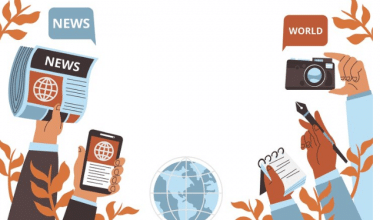Have you ever paused to ponder the transformative power of AI in the public relations (PR) landscape? Picture this: a world where AI in PR tools not only streamlines our workflow but also redefines the boundaries of what’s possible in the industry. It’s fascinating to think about. Yes, it has a lot of benefits, but what about the risk? I can’t help but wonder: are we standing on the brink of a revolution that will forever change how we connect with our audiences, or are we treading into uncharted waters that could reshape our industry in ways we’re not yet ready to handle?
Let’s explore this together and uncover the true potential of AI in the world of public relations.
Key Points
- AI is changing how we do PR work by making tasks quicker and more accurate. But, it could also lead to problems, especially in how we talk to people.
- AI helps in PR by quickly looking at lots of information, helping manage social media, writing press releases, and talking to customers.
- People working in PR need to learn how to use AI tools properly to improve their work.
- Tools like ChatGPT can help write content, but they’re not perfect. They might use your information, and they’re not always up-to-date.
- To use AI well in PR, we need to mix it with our own skills and creativity, making sure we still connect with people effectively.
What Is AI in Public Relations?

In the world of public relations, the role of artificial intelligence is not only growing but also bringing about revolutionary changes. Due to the reliance of many PR activities on the digital realm, the power of AI to sift through and analyze enormous amounts of data quickly is proving invaluable. Tasks that would normally take a human team days to accomplish can now be completed by AI in a matter of seconds, offering insights that are not only quicker to obtain but also more precise and current.
Moreover, AI tools are becoming increasingly useful for streamlining routine tasks in the PR sector. They’re capable of handling a variety of chores, from scheduling and overseeing social media content and crafting press releases to engaging with customer feedback across emails and social platforms, curating media contact lists, and even note-taking. As the functionalities of AI continue to expand, it’s becoming crucial for those in public relations to learn how to leverage AI technology effectively.
AI in PR Tools
AI (Artificial Intelligence) in PR (Public Relations) tools refers to the integration of machine learning and natural language processing technologies to automate, enhance, and streamline various PR tasks. These tools can significantly improve efficiency and effectiveness in several areas:
- Content Creation: AI-powered tools like ChatGPT and Jasper can assist in drafting press releases, writing engaging content, and generating creative ideas. They can help formulate well-structured and compelling narratives, making the content creation process faster and more efficient.
- Media Monitoring and Analysis: AI can monitor a vast array of media outlets and platforms in real-time, providing PR professionals with immediate insights into brand mentions, public sentiment, and emerging trends. This helps in understanding the impact of PR campaigns and in making informed decisions.
- Personalization: AI can analyze data to create personalized pitches and content tailored to specific journalists or influencers, increasing the relevance and effectiveness of PR outreach.
- Email Automation: Tools equipped with AI can automate the process of sending out press releases and follow-up emails, ensuring that communications are timely and targeted.
- Speech and Image Recognition: AI technologies like Synthesia can convert text into videos using avatars, offering innovative ways to present press releases or PR content. This caters to the growing preference for video content across platforms.
- Grammar and Style Enhancement: Tools like Grammarly use AI to improve the grammar, tone, and style of written content, ensuring that it is polished and professional.
AI in PR tools represents a powerful ally for PR professionals, streamlining routine tasks, offering new capabilities, and allowing them to focus on strategic decision-making and creative aspects of their roles. However, a balanced approach, combining AI’s efficiency with human insight and expertise, is key to maximizing its benefits in the PR domain.
Focusing on How These AI Tools Help in PR and Their Downsides:
#1. ChatGPT
Pros
ChatGPT is super popular for chatting and answering questions because it understands and uses language really well. PR pros love it for making press releases, coming up with ideas, doing research, and writing emails. Getting it to do what you want involves asking the right way, something we’ve talked about before.
Cons
But, it’s not perfect. If you share info with ChatGPT, that data is used to make it smarter, which might not be great if you’re sharing secret stuff. It’s also a bit behind on current events since it stopped learning new things in January 2022. Plus, making a press release can be tricky without the right instructions.
#2. Grammarly
Pros
Grammarly, known for fixing grammar, now has GrammarlyGO to help make your writing sound better with just one click. It can change the style, tone, and formality of your text, great for PR folks needing a quick check on their work.
Cons
However, its advice might not always be spot-on. Also, remember that it learns from what you write, so be cautious with sensitive content.
#3. Synthesia
Pros
Synthesia lets you create videos from text. It’s a game-changer for PR if you need a quick video and don’t have time for filming. It offers lots of avatars and languages, showing us what future media might look like.
Cons
The videos don’t totally feel like they’re shot with a real camera, and if you’re not paying much, you can’t make a lot of videos.
#4. Jasper
Pros
Before everyone was talking about ChatGPT, Jasper was the go-to for AI writing help, great for writing anything PR-related. It can manage lots of tasks if you tell it what to do.
Cons
Jasper can be expensive and isn’t the best for longer content without a lot of guidance.
#5. Canva
Pros
Canva makes it easy for anyone to design stuff online. With its AI, you just type what you want, and it creates images for you. This is perfect for when you need a specific image for PR.
Cons
The free version limits how many images you can make, and there might be copyright issues depending on where you are.
In summary, these tools are awesome for making PR tasks easier, but remember their limits and the importance of not sharing sensitive information.
AI in the PR Industry
In the Public Relations (PR) industry, Artificial Intelligence (AI) refers to the application of machine learning, natural language processing, and other AI technologies to automate, enhance, and optimize various PR tasks. These AI-powered tools can significantly boost efficiency and effectiveness across several aspects of PR work.

How to Use AI in Public Relations
AI is used in public relations (PR) in many innovative ways to make tasks easier and more efficient. Here’s a simple breakdown:
Chatbots: These are AI systems that can chat with people, answer their questions, and even make personalized suggestions. They’re not just for customer service anymore but also help with other tasks inside companies, making things run smoother and keeping customers happy.
Speech-to-Text Tools: These tools convert spoken words into written text. PR professionals use them to quickly transcribe press conferences and interviews or create written materials like speeches.
Social Media Automation: AI helps manage social media by scheduling posts, responding to comments, and helping teams work better together. This saves a lot of time and ensures messages get to the right people at the right time.
Content Creation: AI, like the technology behind ChatGPT, can create new written content, ranging from press releases to social media updates, tailored to different audiences. It can also create visuals and videos quickly, although it’s important to keep humans in the loop to ensure quality.
Media Outreach: AI makes finding and connecting with journalists and influencers easier by identifying updates in their information and suggesting new contacts based on your history. This streamlines the process of building relationships.
Media Monitoring: With the internet growing rapidly, AI helps sift through vast amounts of data to find relevant media stories for your brand. The effectiveness of this depends on the quality of the data it has access to.
Sentiment Analysis: AI takes tracking how people feel about your brand to a new level by understanding the context and nuances of what they’re saying, giving a clearer picture of public opinion.
Will AI Take over PR?
Will AI take over PR jobs? Not really. AI is changing how things are done in Public Relations (PR), making tasks like writing content, monitoring media, and sending out emails much faster and more efficient. Tools like ChatGPT and Grammarly are great examples of how AI can help with writing and checking your work, but that doesn’t mean AI will replace PR professionals. Are you still confused as to why it will not take over?
Well, let me break it down PR is all about connecting with people, understanding what they feel, and building relationships. AI is super smart with data and trends but can’t match the human touch in understanding emotions or crafting messages that truly resonate with people. Plus, making strategic decisions and being creative in a way that really speaks to humans? PR pros excel at that, and AI isn’t there yet.
So, think of AI as a super helpful assistant in PR. It’s there to take care of the repetitive stuff and give you insights you might not have spotted on your own. But when it comes to the heart of PR storytelling, relationship building, and strategic thinking that’s where you shine. AI in PR? It’s all about teamwork.
Checklist on How to Effectively Implement AI in Your PR Strategy
The Biggest Benefits of Artificial Intelligence in Public Relations

Let’s look closer at how PR pros profit from AI in communication today.
#1. Increased Efficiency and Productivity with AI
A significant 61.4% of early AI adopters in the field of communication have reported notable improvements in efficiency and productivity. This is largely attributed to AI’s capability to automate mundane tasks, which 76.6% of PR professionals are taking advantage of, thus allowing more time dedicated to strategic planning.
#2. Faster and More Efficient Research
AI’s impact is also evident in research processes, where 58.7% of PR professionals report quicker information gathering from social media and other platforms, thanks to AI tools. This streamlining of research is further exemplified by the rollout of Google’s AI chatbot, Bard, in Europe and Brazil, enhancing research speed and accessibility.
#3. Cost Reduction in PR Activities
Around 43.5% of respondents have observed a decrease in costs and resources needed for PR activities, thanks to AI. This reduction is a result of minimized manual labor for repetitive tasks and faster, more efficient content creation and research, highlighting AI’s role in cost-saving.
#4. Enhanced Content Creation
AI is also revolutionizing content creation, with 42.2% of respondents utilizing it to improve communication efforts. From generating personalized messages to crafting social media content, AI aids in making the content creation process more efficient, though it still requires human intelligence to achieve the best results.
#5. Data-Driven Insights for PR
AI contributes significantly to media monitoring and analysis, providing valuable insights for PR activities. 27.9% and 27.5% of respondents have benefited from AI’s ability to analyze social media posts and articles, perform sentiment analysis, and furnish real-time data on PR and marketing campaign performance, thus offering substantial time savings and rich data for PR reporting.
RISKS in using AI in Public Relations
AI in Public Relations (PR) presents several risks that must be carefully managed to ensure successful implementation and avoid potential pitfalls. These risks include:
#1. Ethical Concerns
AI can generate content or interact in ways that may not always align with ethical standards or brand values. This includes biases in AI algorithms that can result in discriminatory content or actions.
#2. Loss of Human Touch
Over-reliance on AI for communication tasks can result in messages that lack the empathy, understanding, and personal touch that human PR professionals can provide. This might negatively affect the brand’s relationship with its audience.
#3. Privacy Issues
AI systems often require access to large amounts of data, raising concerns about privacy and data protection. Misuse or unauthorized access to this data could lead to serious privacy breaches.
#4. Dependence on Technology
Heavy reliance on AI tools can lead to a lack of critical thinking and creativity among PR professionals. It can also create a dependency that might be problematic if the technology fails or is unavailable.
#5. Misinformation and Manipulation
AI-generated content can be used to create fake news or manipulate information, damaging a brand’s reputation and public trust. Ensuring the veracity of AI-generated content is a significant challenge.
#6. Job Displacement
The automation of tasks traditionally performed by humans can lead to job displacement within the PR industry. This requires a shift in skill sets and roles, which can be disruptive.
#7. Security Risks
AI systems are vulnerable to hacking and other cybersecurity threats. An attack could disrupt PR operations and compromise sensitive information.
#8. Legal and Regulatory Compliance
As AI technology evolves, so do legal and regulatory frameworks. Keeping up with these changes and ensuring compliance can be challenging for PR professionals using AI tools.
#9. Misinterpretation of Data
AI’s ability to analyze and interpret large datasets can lead to invaluable insights. However, without proper context or understanding, there’s a risk of misinterpreting this data, leading to misguided PR strategies.
#10. Reputation Risk
The misuse of AI in PR, whether through ethical lapses, privacy breaches, or simply ineffective communication, can itself become a source of negative publicity and harm a brand’s reputation.
Mitigating these risks involves careful planning, ethical consideration, transparency, constant monitoring of AI activities, and maintaining a balance between automated and human-driven processes in PR strategies.
Embracing AI in Public Relations
As technology advances and becomes more accessible, we understand the power of strategic public relations in amplifying your personal and company brand presence while resonating with your target audience. Our service extends beyond just writing. We offer expert advice on crafting your message, delivering it effectively, and getting it in front of the right people at the right moment using the most impactful methods.
Related Posts
- PR for B2B Companies: Tailoring Your Approach to Reach Decision-Makers
- AIPRM PROMPTS FOR COMMUNITY RELATIONS IN 2024
- Best 2024 PR Campaigns & Practical Examples (Detailed Guide)
- 21 Event Press Release Templates & Examples That Inspires Me






